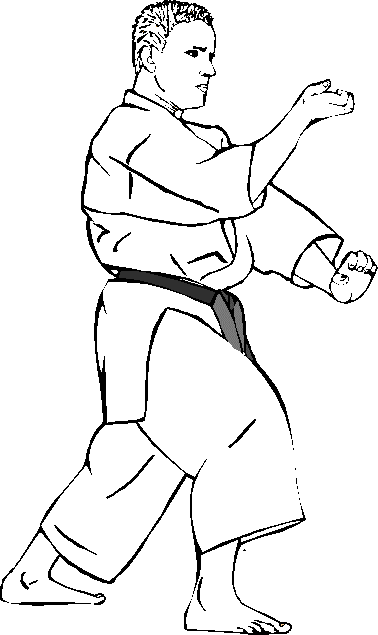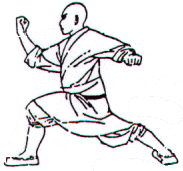|
| |

OKINAWAN SHURI-RYU KARATE-DO
- TAIKYOKU ICHI (1), NI (2), SAN (3) - First Cause
- WANSU - Strong Arm Dumping Kata
- ANAKU - A Swallow on the Beach and Pivoting Form
- NAIFANCHI KATA Shodan(1st level), Nidan(2nd level), Sandan(3rd level)
Iron Horse Form, to straddle a horse
- SANCHIN KATA - Three Conflicts
- EMPI-SHO - Flying Swallow Form
- BASSAI-DAI - Breaking or Penetrating ones Fortress or Defense
- GOPEI-SHO - Peacocks Methods of Tearing or Ripping
- DAN ENN SHO -Hsing-Yi's Hand Attacks Through the Fire or Heat
- KANKU SHO - A lesser version kata of Kushanku / in Viewing the Sky
- TENSHO - Revolving Hands or Change of Grips
OKINAWAN SHURI-RYU PAGE
Ryukyu Karate-do
(The Okinawan Way of the Open hand)

Okinawa is the main
island of an archipelago known as the Ryukyu (rhee-you que)
Archipelago. This is a seven hundred mile long island chain which extends
from
southern Japan to Taiwan. The name Ryukyu is of Chinese derivation,
composed
of two Chinese characters RYU=meaning flow, and KYU=meaning seek.

In 1917, an Okinawan
named Funakoshi, Gichin traveled to Kyoto, Japan to
demonstrate Okinawan Martial Arts
at the Butokuden in order to spur interest
within
the Dai Nippon Butoku kai. In 1922, he made a second trip to Tokyo,
Japan at the request of Japanese Military
Officials, and formally introduced
Okinawan Martial Art Hanshi's (Masters) to Japan's mainland.
8th Dan Shihan -
Chief Instructor
Karate-do has been a way of life for Kyoshi Rabino ever
since he set foot into O'Sensei's dojo at the age of 13 in Phoenix, Az, by initially being trained by his brother Sam Rabino in Chinese
Gung-fu. Though the path was often long and arduous, it brought to his life a sense of peace, harmony and a
certain fulfillment of his cultural heritage, Pete was born to be a fighter, and today credits Grandmaster
Trias with channeling his fighting spirit in a positive direction. With the structured training of the Trias
Dojo, Mr. Rabino quickly established himself as an outstanding competitor in both
Kumite and Kata. He won the USKA
Grand nationals from 69-73. He is remembered by many for his lightning fast backhand and deceptive drop
kick, both of which he used on the day he come out of retirement to place in the Masters division of the 1985
World Karate Championships in Houston, Texas. In 1971 Master Trias appointed Mr. Rabino as one of the
first Chief Instructors at the Hombu Dojo, and in 1974 he was elected into the Trias International
Society.

HSING-YI (WU SHU)
Chinese Martial Arts
Because Hsing Yi is a prototype of Shuri-ryu, the Shuri-ryu student should familiarize
themselves with the core of our system. The name, "Hsing-yi," means "imaginary intellectual fist," and
represents" the feel of the human mind."
Hsing-yi combines both Pa-kua and Tai chi chuan methods in a harmonious unity. It is also
believed that Pa-kua and Tai chi chuan took principles of Hsing-yi and adapted them to their own
use.
1. There are three main schools:
a. Shansi - founded by Tsao Chi Wu
b. Hunan - founded by Ma Hsueh Li
c. Hopei - founded by Li Neng Jan
2. There are five (5) forms:
a. Splitting - (Pi chuan) breaking with and against the bone grain between the
joints.
b. Crushing - (Peng-chuan) to push against, press, squash, mash or squeeze.
c. Drilling - (Tsuan-chuan) twisting, turning against vulnerable areas and nerve centers.
d. Pounding - (Pao-chuan) repeating and repetition of heavy blows to the same area over
and over again (fatal areas, etc.)
e. Crossing - (Heng-chuan) where the bones cross, such as strikes to joints, twisting
limbs by crossing.
3. Hsing-yi system (Pa Su Cheun style)
a. consists mostly of linear movements.
b. employs flat-footed stances.
c. uses the horse stance (kiba) as its major stance.
d. utilizes an elaborate two-man fighting form.
e. is soft with flowing movements.
4. Forms of exercise:
a. Turning bricks over
b. Squeezing vine bundles
c. Bending bows
d. Twisting heavy rope
e. Bag grabbing and throwing
f. Snapping or pinching beans, small rocks, etc.
5. There are twelve (12) styles:
a. Dragon g. Cock
b. Eagle h. Iguana
c. Tiger i. Swallow
d. Monkey j. Ostrich
e. Hawk k. Snake
f. Horse l. Bear
6. Pushing hand techniques
a. Tui-shou
b. Wu wei - effortlessness, non striving, non grasping (Taoist)
c. Emptying (Buddhist)
d. Ke-chi - to subdue the self (Confucius) - yield to others or all things, thus squashing
egoism, personal
identity, obstinacy (stubbornness) and selfishness.
ORIGINAL BASIC SHURI-RYU KARATE-DO
EXERCISE FORMS

Hsing-Yi Chuan (Pa su Cheun style) is an internal (yin) system which is based on the five
(5) primary elements of earth, water, fire, metal, wood and the imperturbable flow of chi (energy) along with
converted breathing. The five elements contain five movements of force and directness (chuans)
which are known
to us as crossing,
drilling, pounding, splitting and crushing. Part of the five elements philosophical theory
is the notion that these elements successively produce (generate) and destroy (counter) each other in a rigidly
defined system of mutual complement and antagonism. Since Hsing-Yi is a prototype of Shuri-ryu, we hope that those
that follow the Shuri way will better understand the origins of where out system developed. Pa su
Cheun developed in Southern China from the Hang styles that stress power with long and short hand techniques, low and
wide stances with
flowing and quick movements when moving from one stance to another. Southern Hsing-Yi
stress the use of the hands and the Northern styles stress the use of the feet. It is said in Hsing-Yi that when
the hands move in straight lines the feet move in circles and when the hands move in circles the feet move in
straight lines.
The following are eight basic forms:
Form #1 - Stand in natural close horse stance (guan ma bo) with hands at the sides. Raise
up both hands (palms down-arms straight) with a deep inhale until the arms are both in front of and
slightly over the head. At the same time raise slowly on both balls of the feet. Bring hands and both feet down
slowly and exhale through the nose. The hands should now be nose level and in front of the face (palms
down-arms straight).
Form #2 - Thrust both hands slowly in front of the body (palms up) and slowly step forward
with the left foot. Bring the right foot behind into a left short cross stance (kosa-dachi or ding
bo).
Form #3 - Step back with the right foot and draw the left foot back into a left cross
stance. Bring the hands quickly and with power (closed into fists) back to the body in a guard position.
Form #4 - Step forward with the left foot, then the right foot into a right cross stance
and execute a right punch.
Form #5 - Shuffle step with the right foot followed by the left foot into a right cross
stance and execute a left punch.
Form #6 - Jump forward slowly into a right cross stance and slowly execute a right
augmented middle block.
Form #7 - Step forward with the right foot into an extended jungle or rabbit stance
(mitsurin dachi or tsuki bo) and simultaneously quickly and with power execute a right high block and a left vertical
punch.
Form #8 - Pivot on the left foot quickly to the left into a left cross stance. The left
hand extends to the front (palm down) and the right hand pushes down to the right side into a guard position.
EXECUTION OF FORMS
All stance movement and block is done very smooth and slow. The striking movements
are
executed quickly and with explosive power.
Form #1 - (Hsing Yi - Yi Huo) It is performed by moving forward (I pattern) with the first
five forms. Jump-shift around and go back with the same 1 to 5 forms only this time in a reverse position.
Form #2 - (Hsing Yi - Er Mu) The performer goes through the first five forms of Hsing-Yi
-Yi Hu and adds forms 6 to 8 (I pattern). Jump-shift around and go through the entire 1 to 8 forms again this
time in reverse.
Form #3 - (Hsing Yi - San Tu) The performer goes through the first five forms of Hsing-Yi
- Er Mu (I pattern) and turns to the right (L pattern) and performs forms 6 to 8. Jump shift around and perform the same
pattern in reverse.
Form #4 - (Hsing Yi - Si Pi) The performer goes through the first five forms of Hsing-Yi
Er Mu (I pattern) and turns to the left (L pattern) and performs forms 6 to 8. Jump-shift around and perform the same
pattern in reverse.

|

